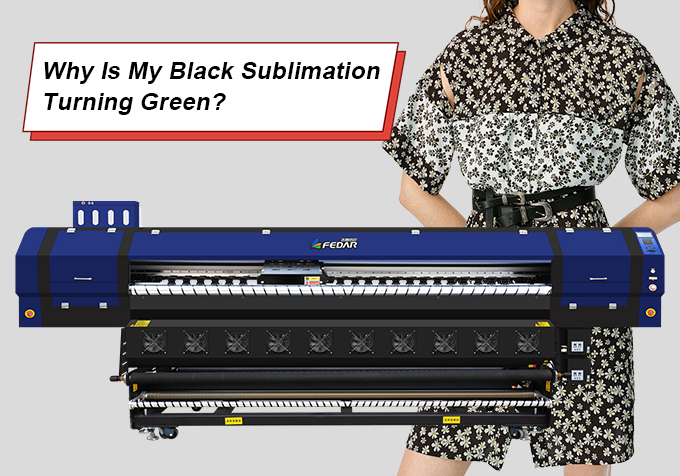23
Aug
Sublimation is, simply put, a process in which a solid substance, say dye ink, turns into a gas under heat and pressure, skipping the liquid phase. Sublimation printing produces crisp, vibrant, and durable results because the gas gets immersed in the substrate, making it a go-to printing method for many. However, printers often encounter the problem of color distortion, like black prints turning green.

Imagine your frustration when you’re excited for your bold, truly black design and it turns out an ugly shade of green. Getting the colors of your design right is the single most crucial element in your product, as the creative genius in you deserves to be rewarded with the actualization of its vision. A project taking a dark turn, or in this case, a green turn, is a huge turn-off. We’ll teach you why this happens and how to avoid it:
Several factors affect how the colors finally appear on the product, ranging from heat and pressure settings to ink quality and substrate properties. We’ll discuss them all one by one:
1. Temperature and Pressure Settings
If the heat settings are not optimal, the solid dye might not completely convert into gaseous form, this negatively affects its ability to permeate into the material. Insufficient heat also leads to inadequate color saturation and weak bonding between the ink and the substrate. The black dye thus often turns greenish.
Just like heat, pressure settings also affect the final color output. Insufficient pressure results in improper and uneven dye distribution. Moreover, the ink doesn’t get completely transferred to the material, leading to color distortion or defects.
The quality of sublimation inks significantly impacts the final output. Subpar inks usually have flawed chemical formulations. This compromises their ability to completely transform into gases during the sublimation process. Low-quality dyes form a weaker bond with the substrate material and don’t penetrate successfully, resulting in color distortion, low saturation, and blurry prints. A substandard black ink might appear green on the final print.
Furthermore, ink compatibility plays a vital role in sublimation printing. Ink compatible with one type of material might not produce the same crisp results when used with other materials. A mismatch between ink and substrate means weak adhesion, resulting in unexpected color changes, especially with black inks.
An understanding of the substrate composition is crucial for sublimation printing. Commonly used materials like polyester have unique properties that facilitate better ink absorption and adhesion. Variation in substrate materials or their surface treatment leads to unwanted outcomes in color and clarity. The surface coating might chemically react with the black ink to produce a green effect.
Furthermore, uneven or coarse surfaces don’t allow complete ink transfer and uniform ink distribution. A design initially conceived in a black finish might take on a green tint because of these factors. In addition, different materials require different temperature and pressure settings for optimal results. Incorrect settings affect adhesion and penetration, causing black ink to turn green.
Color distortion is easily avoidable with just a few basic steps. Sublimation printing demands consistent learning, experimentation, and knowledge upgradation. To ensure that the final output is a spitting image of your vision, you need to follow these few simple steps:
Most sublimation ink manufacturers specify a recommended temperature for their inks. Be sure to adhere to that range. You can also experiment with different settings within that range to choose what best suits your needs. Black inks usually take on a greenish hue when insufficient heat is applied. They turn brown when overheated.
You need to carefully calibrate your pressure settings according to the composition of your substrate. Avoid using excessive pressure, as it might induce damage to the material. Conversely, a low-pressure setting will hinder the dye ink sublimation. Optimal pressure is an important factor in achieving a durable print.
Printer optimization can be achieved with repeated testing. Slightly variate the heat press and sublimation printer settings when testing small batches to find the perfect setting. Printer and heat press maintenance is essential for avoiding unpredictable outcomes. Your tools and machines are your best friends when producing something; keep them happy, and they’ll keep you happy.
Always choose reputable manufacturers when buying your sublimation inks. You must ensure that the inks you select are compatible with your printer model and substrate material. Incompatibility might result in discoloration and distortion.
Opt for high-quality inks that contain well-formulated dyes and additives to get high-resolution, color-accurate, and durable prints. Follow the manufacturer’s guidelines to maintain the printer ink cartridges to avoid inconsistencies in your final designs.
Choose materials that have specifically been prepared or recommended for sublimation printing. The most commonly used material for sublimation is polyester as it allows for complete ink absorption. Surfaces with coatings made for sublimation ink reception are also a good fit.
The substrate you choose must be compatible with your ink and printer model to avoid color distortion. In addition, consider your material’s properties, like heat resistance and ink absorption rates. Choose even and smooth surfaces for a uniform output.
Achieving an elegant yet rich, deep black finish in your prints is tricky, but it is possible by understanding the issue in-depth and taking a few measures. By ensuring temperature and pressure optimization, proper printer and heat press maintenance, and choosing quality products, the risk of color distortion can be eliminated.
Following the manufacturer’s guidelines and a little trial and error goes a long way. You must remember not to give up on your dreams if you hit a roadblock, for repeated failure leads the way to success.
If there's anything we can do to further showcase machines' features, please let us know.
Email: sale@fedar.net
Whatsapp: +86 15515715397
Our company has over 30 models of printers with independent intellectual property rights and patents. Marketed under the esteemed brands of Skycolor, Stormjet, and Fedar brands, these printers cover a wide range, including digital textile printers, UV printers, eco-solvent printers and more. Known for their exceptional quality and performance.
